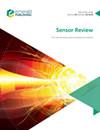Evaluation of seawater monitoring for the detection of Escherichia coli and Enterococcus faecalis on an integrated biosensor system
IF 1.4
4区 工程技术
Q3 INSTRUMENTS & INSTRUMENTATION
引用次数: 0
Abstract
Purpose This study aims to monitor seawater by determing two biological indicators, Escherichia coli and Enterococcus faecalis. The process of following standard procedures is mainly time-consuming. Thus, there is a demand for a biosensor, an appropriate device for rapid and accurate results that can give information about the microbiological quality of seawater in an effective and rapid way. Design/methodology/approach In the gold standard method for seawater monitoring, the filter method is applied as a condensation step. In this work, the authors evaluated six types of common syringe filters for bacteria concentration and then the best filter was used for seawater analysis for E. coli and Enterococci with loop-mediated isothermal amplification (LAMP) polymerase chain reaction (PCR). Findings Cellulose acetate filter had the highest efficiency (98%) for bacterial concentration. The limit of detection of the LAMP method was 104/1,000 mL for both E. coli and E. faecalis. The proposed method could be used for the development of seawater biosensors with advantages such as a simple heating element and the speed that the LAMP PCR presents. Originality/value The suggested protocol is proposed in an integrated in situ system, a biosensor, for seawater quality determination.集成生物传感器系统在海水监测中检测大肠杆菌和粪肠球菌的效果评价
目的通过测定大肠杆菌和粪肠球菌两种生物指标,对海水进行监测。遵循标准程序的过程主要耗时。因此,需要一种生物传感器,一种用于快速准确结果的合适设备,能够以有效和快速的方式提供关于海水微生物质量的信息。设计/方法/方法在海水监测的金标准方法中,过滤法被用作冷凝步骤。在这项工作中,作者对六种常见的注射器过滤器的细菌浓度进行了评估,然后将最佳过滤器用于环介导等温扩增(LAMP)聚合酶链式反应(PCR)对大肠杆菌和肠球菌的海水分析。发现乙酸纤维素过滤器对细菌浓度的效率最高(98%)。LAMP方法的检测限为104/1000 大肠杆菌和粪大肠杆菌均为mL。所提出的方法可用于开发海水生物传感器,具有加热元件简单和LAMP PCR速度快等优点。独创性/价值建议的方案是在一个集成的原位系统,一个生物传感器中提出的,用于海水质量测定。
本文章由计算机程序翻译,如有差异,请以英文原文为准。
求助全文
约1分钟内获得全文
求助全文
来源期刊

Sensor Review
工程技术-仪器仪表
CiteScore
3.40
自引率
6.20%
发文量
50
审稿时长
3.7 months
期刊介绍:
Sensor Review publishes peer reviewed state-of-the-art articles and specially commissioned technology reviews. Each issue of this multidisciplinary journal includes high quality original content covering all aspects of sensors and their applications, and reflecting the most interesting and strategically important research and development activities from around the world. Because of this, readers can stay at the very forefront of high technology sensor developments.
Emphasis is placed on detailed independent regular and review articles identifying the full range of sensors currently available for specific applications, as well as highlighting those areas of technology showing great potential for the future. The journal encourages authors to consider the practical and social implications of their articles.
All articles undergo a rigorous double-blind peer review process which involves an initial assessment of suitability of an article for the journal followed by sending it to, at least two reviewers in the field if deemed suitable.
Sensor Review’s coverage includes, but is not restricted to:
Mechanical sensors – position, displacement, proximity, velocity, acceleration, vibration, force, torque, pressure, and flow sensors
Electric and magnetic sensors – resistance, inductive, capacitive, piezoelectric, eddy-current, electromagnetic, photoelectric, and thermoelectric sensors
Temperature sensors, infrared sensors, humidity sensors
Optical, electro-optical and fibre-optic sensors and systems, photonic sensors
Biosensors, wearable and implantable sensors and systems, immunosensors
Gas and chemical sensors and systems, polymer sensors
Acoustic and ultrasonic sensors
Haptic sensors and devices
Smart and intelligent sensors and systems
Nanosensors, NEMS, MEMS, and BioMEMS
Quantum sensors
Sensor systems: sensor data fusion, signals, processing and interfacing, signal conditioning.
 求助内容:
求助内容: 应助结果提醒方式:
应助结果提醒方式:


